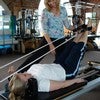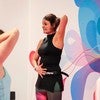Description
About This Video
Transcript
Read Full Transcript
Hi. My name is Benjamin Dagenhart. I'm a Pilates teacher and educator, and I'm here for Pilates anytime to give you an introduction to the Pilates Cadillac. What is a Cadillac? I'm sitting on one right now. It's a piece of apparatus that we use in a fully traditional equipped studio.
A lot of people think of Pilates as something that happens on a mat, increasingly, there are reformer classes that people now connect to Pilates as well. In a fully equipped studio, there's a lot more equipment to play with, including the Cadillac. So if you're unfamiliar with it or less familiar than with the mats, or the reformer. You may have seen 1, but you don't know what's happening on it. This video is for you. First of all, why is it called a Cadillac?
There are many different versions of this story. There's a lot of Pilates history that we're still trying to piece together, but the way that the Cadillac, as we know, it evolved, started sometime in the 1930s, 1940s. Joseph Pilates, who's the founder and namesake of the Pilates method, was a very avid tinkerer and inventor who played around with his ideas around movement and movement training by also synthesizing that with an understanding of how apparatus specialized apparatus can really inform and reform the way that a body moves and approaches any kind of movement challenge. One of the first versions of the Cadillac that we know of was actually called the bednasium, and it was a regular sized bed with a headboard that you could attach springs to. It then evolved into what Joseph Pilates called the massage table, which had additional attachments for springs, And over time, it evolved into what we now know as the Cadillac. And it has, according to oral history, It has its name from the fact that in comparison to the magnesium in the massage table, the Cadillac was the most fully evolved and had all the bells and whistles, just like the Cadillac car.
Another name for the Cadillac, as we know it, that you might hear is the trapece table because in addition to what the original bednasium and massage table featured in terms of props, which we'll go over in a second, The Cadillac has an actual trapeze attachment that we work with quite a bit on the Cadillac. So what is a Cadillac used for who would benefit from a workout on it and how does it fit into the Pilates method as we know it? Well, I think from a teacher's perspective, the way to describe the Cadillac is sort of as a movement laboratory. It's a very supportive and sturdy environment for the moving body to be on as you explore all the different exercise and movement challenges. It's an easy access piece of apparatus. We don't have to squat down to get to the floor.
It's readily available for just about anyone who might have mobility issues to otherwise enter the equipment. And from a teacher's perspective, the moving body is right in front of us. So equally to the fact that the practitioner doesn't have to squat down towards the floor to get on the equipment. The moving body is right in front of the teacher. Which makes it a really great environment for teacher and student to really get to know each other and to zoom in on any movement that happens on the Cadillac. In addition to that, you will see that there's all kinds of attachment points for springs virtually anywhere around the moving body.
As I said, Joseph Pilates was a very avid tinkerer and inventor. And over time, we see that there were additional attachments for additional springs and different props to be brought into the work to virtually train every part of the body as needed. In addition to that, we also have the canopy and the framework of the Cadillac, which does not only serve as an attachment point for springs, It also is a great visual reference for the moving body. When you lie down on a Cadillac, again, you'll appreciate the fact that it's easily accessible, because it's raised off the ground that it's sturdy and supportive, but the second you lie down, you will also see the rectangular shapes and the lines in space around you, and they help as a visual grid for you to align yourself within. And because Pilates is all about aligning and attaching springs to the body.
It always serves you best to know where you are in space, and the visual framework of the Cadillac is really helpful with that. So what kind of workouts can you expect from a Cadillac? Well, the Cadillac is probably the most versatile piece of equipment that we have in the Pilates studio. And virtually any repertoire from, say, the mat or the reformer could be replicated on the Cadillac. You can do your entire math work on here. We can attach springs to the proper places to mimic some of the work that we can do on the reformer as well as from the chairs and barrels. Literally, just about any movement you can think of can be practiced on the Cadillac and makes it a really great place. To practice the exercise because of the variety and how we can attach springs.
So when you get on a cadillac, depending on your fitness level, your ability level, and your current goals, your teacher can regress the intensity of the workout way down to a very remedial restorative or exploratory workout, as well as take it all the way up into super athletic and gymnastic realm of exercises by using the canopy by going into more advanced inversions because in addition to being an inventor Joseph Pilates was also a gymnast. So we see a lot of that influence reflected in the original work. So as far as what kind of workout you can expect, you get to choose your own adventure and you can regress it way down and progress it all the way up. Of course, your teacher will have a say in that. So if you're wondering, is the Cadillac something that would be great for me? What kind of student would benefit from working out on the Cadillac?
The answer is yes, everybody would benefit from integrating the Cadillac into their Pilates practice because it informs the way that you do exercises on the reformer or mat or virtually any other form of exercise so well because it gives the teacher an opportunity to pinpoint and highlight and pick and choose the right spring for the right body part from the right angle to really zoom in on your specific needs. So the Cadillac really is a great piece of equipment for everyone who loves Pilates and is interested in Pilates to experience. Alright. We talked about the Cadillac quite a bit. Let's take a closer look at what it actually is made of and what it consists of. The the main piece of it that you've been looking at all along is obviously the race mat, which allows us to lie down on Neil on stand on for a variety of exercises. This is the main place where the magic happens. Typically, depending on who made the Cadillac that you work on, has a well padded mat on top that provides good support for the spine and joints for when we lie down on it.
Let's stand up and take a look at what else we have because as the name Cadillac implies, there is a lot of bells and whistles to be found So like I mentioned, there are lots of attachment points all around and all across the framework of the Cadillac and its canopy on top. So these spring attachments typically serve a particular type of exercise and a particular type of prop, but the springs that we use usually have anywhere from 3 to 5 different strengths, and a teacher will be able to pick out the one that's right for you, right for the exercise, as well as pick the angle that is appropriate for the movement you're about to embark on. A lot of the these involve props like this rollback bar, which allows the body to really explore spinal articulation in a way that is super supported by moving along with the springs. Below that, we typically find a set of other springs that are often called and referred to as arms springs or leg springs, implying the body part that is attached to the spring, and the portion of the body, per versus lower that is going to be called to work. Again, all of these exercises typically happen lying down on this mat.
So as you can see, for me as a teacher, this is a really great place to work with a body. So this is what lives on one side of the Cadillac. And again, depending on who made the Cadillac you're working on, you might see additional attachment points on the side. On the opposite end so that you can do standing work outside of it as well. Let's take a look at what lives over here.
On this side, opposite of where the rollback bar lives, we typically have something called the push through bar. And what's unique about this piece of apparatus is that it doesn't travel straight up or down, like a lot of the Pilates equipment does. It extends in one direction contracts into the same direction backwards. Here we have sort of a half circular semi circular trajectory that allows for a wide range of movement to accommodate the bending of the spine the extension of the spine. And in a lot of ways, the movement of the apparatus and Pilates often mimics the way that our body should move as well in the same way that the springs mimic the way that we want to use our muscles in a way that elongates and stretches. That's our push through bar.
It can be catch with a spring from above, with a spring from below, again, serving for a variety of exercises, making this a very versatile prop to work with. And then we have the trapeze, which is why this is also called the trapeze table. The trapeze consists of 2 vertically hanging springs. We very often find that this is used with the feet in either the sling below it or support it on what's typically a padded piece of a crossbar on top of it. So the fact that this is not hanging off of ropes or chains and that there are springs attached to it, again, allow for a lot of visual feedback for both the practitioner and the teacher, but also for a really fun way to engage with this. And it's often used as a departure point into work that happens on top of the Cadillac, gymnastic inversions and the like using the trapeze as a way to step into it.
And then another very common prop that is worth talking about are these little sheepskin fluffy hanging straps. The cuff that is really well cushioned, as you can see, serves to hold the ankles of the moving body. And what you do with these typically has a lot to do with hanging upside down. Imagine your feet in here, your body will slide off the table in that direction, bringing the body into full inversion of complete decompression of the body. And, yes, there's no other place, but the Pilates Cadillac way can do this. And if you ask me, that's what got me hooked on Pilates. So if you get a chance to experience as I highly recommend it, other pieces of props that can be attached to the Cadillac include the next stretcher, which is a piece of apparatus that has a headband, that works with and for you on neck alignment and just awareness of the length of your spine. There's an airplane board which is attached to the feet.
And there are probably a lot of other pieces that your teacher will bring in from a creative standpoint. So the Cadillac in a lot of ways is really this never ending playground for movement exploration. Obviously, there's much more to discover about the Cadillac, but I think the way to do that is to get on 1. Another great way to learn more about the Cadillac is, of course, looking at the classes that exist on Pilates anytime that are taught on this piece of apparatus. I hope you'll check it out in person at some point. Thank you so much for watching. See you in class.
Comments
You need to be a subscriber to post a comment.
Please Log In or Create an Account to start your free trial.












